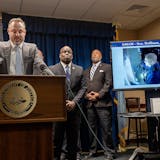When Sara Kettering needed a COVID-19 test earlier this month, she grabbed her Microsoft Surface tablet to look for an appointment. The most convenient option: one of Minnesota's "community testing sites."
Unlike for the COVID test she took last spring, the Minneapolis resident didn't need a video consultation with a doctor ahead of time. Instead, she filled out an online form and scheduled a test within the next few days at Roy Wilkins Auditorium at St. Paul's RiverCentre. The appointment even came with free parking.
"Super slick," is how Kettering, who recently graduated with a master's degree from the University of Minnesota, described her experience. She was in and out quickly. The saliva test was less intimidating than a nasal swab. Results (negative) arrived in about 48 hours. She even tweeted about her experience, "to show my network, my friends how easy it is, to take a little bit of the unknown away and make it more personable, that this is what you do."
With COVID continuing its fierce fall surge, thousands of Minnesotans each day are seeking out testing. Many will find, as Kettering did, that public testing often offers the quickest, most hassle-free option. This commendable reality is the result of smart work done in a matter of months by state health and emergency operations officials to boost state testing capacity.
There are currently 21 community testing sites located across the state offering close-to-home testing to urban and rural Minnesotans, with testing free to those without coverage and insurance generally picking up the cost for those who do.
In addition, a pilot project that offered free at-home saliva kits to residents of select counties has now gone statewide, providing an important new option for those who can't travel to a testing site or prefer not to. This at-home testing effort appears to be the first of its kind in the nation.
These efforts, which are powered by pioneering state partnerships with private test providers, resulted in 123,000 completed weekly COVID tests, according to the most recent statistics available. That is roughly 40% of the total weekly tests reported in Minnesota for the same time period.
Similar data is not readily available for other states for comparison purposes. Still, that percentage is impressive, according to Stephen Kissler, a postdoctoral research fellow at the Harvard T.H. Chan School of Public Health.

![A black bear stopped after crossing Big Bay Road on Madeline Island, the largest of the Apostle Islands in Wisconsin, on Monday, May 31, 2021. ]](https://arc.stimg.co/startribunemedia/PWNYGIY3WTSWDBOGOYD775DPP4.jpg?&w=80&ar=1:1&fit=crop)

